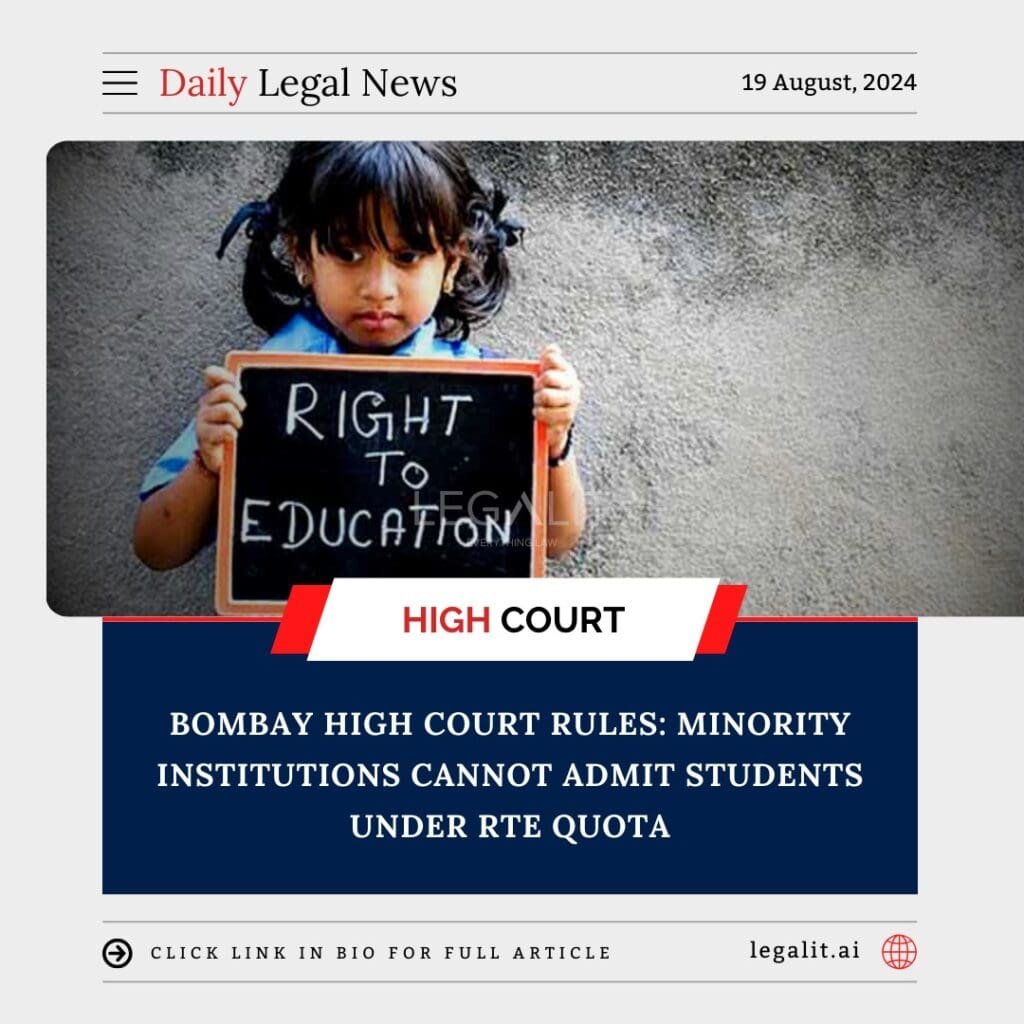
In a significant ruling, the Bombay High Court has held that minority educational institutions are exempt from admitting students under the Right to Education (RTE) quota. This decision reinforces the special protections afforded to minority institutions under the Indian Constitution and clarifies their obligations regarding the RTE Act, which mandates certain educational standards and quotas in non-minority institutions.
Background of the Case
The Right to Education Act, 2009, is a landmark legislation in India that mandates free and compulsory education for children between the ages of 6 and 14. A key provision of the RTE Act requires private unaided schools to reserve 25% of their seats for children from economically weaker sections (EWS) and disadvantaged groups. The government reimburses these schools for the education of these students.
However, minority educational institutions, which are protected under Article 30(1) of the Indian Constitution, have consistently argued that they should be exempt from this provision. Article 30(1) grants minority communities the right to establish and administer their own educational institutions without interference from the state, to preserve their language, culture, and religion.
The case before the Bombay High Court involved a challenge to the applicability of the RTE Act to minority institutions, with petitioners arguing that forcing such institutions to comply with the RTE quota would infringe upon their constitutional rights.
Bombay High Court’s Ruling
- Exemption from RTE Quota: The Bombay High Court ruled that minority educational institutions are not required to admit students under the RTE quota. The Court held that imposing such a requirement would violate the constitutional rights of minority institutions to manage their own affairs, particularly in matters of admissions.
- Protection of Minority Rights: The judgment emphasizes the protection of minority rights as enshrined in the Constitution. The Court recognized that forcing minority institutions to comply with the RTE quota could undermine their ability to preserve and promote their cultural, linguistic, or religious identity.
- Clarification of RTE Act’s Scope: The ruling clarifies that while the RTE Act aims to ensure universal access to education, it does not supersede the constitutional protections granted to minority institutions. This distinction is crucial in balancing the rights of minority communities with the broader goals of the RTE Act.
Implications of the Ruling
The Bombay High Court’s decision has several important implications:
- Reaffirmation of Minority Rights: The ruling reaffirms the special status of minority educational institutions under the Constitution, reinforcing their autonomy in matters related to admissions and administration.
- Impact on RTE Implementation: The decision limits the scope of the RTE Act, particularly in how it applies to minority institutions. This could influence the implementation of the RTE quota, as similar exemptions may be sought by other minority institutions across the country.
- Potential for Further Legal Challenges: The ruling could lead to further legal challenges or clarifications, particularly in states where the application of the RTE Act to minority institutions has been contested. It may also prompt discussions about the balance between universal education and minority rights.
- Policy Considerations: The decision might lead to a re-evaluation of education policies concerning minority institutions, possibly encouraging the government to explore alternative ways to ensure that children from economically weaker sections have access to quality education without infringing on minority rights.
Moving Forward
Following the ruling, several steps may be taken by stakeholders:
- Compliance with the Ruling: Minority institutions will likely review their admission policies to ensure they are in line with the Court’s decision, reinforcing their autonomy in managing admissions.
- Government Response: The government may need to consider how to address the gaps in educational access that might arise due to the exemption of minority institutions from the RTE quota. This could involve increasing support for other schools or finding alternative means to fulfill the objectives of the RTE Act.
- Legal and Public Discourse: The ruling may spark broader legal and public discussions about the rights of minority institutions versus the need for inclusive education policies. These discussions could influence future legislation or amendments to the RTE Act.
- Monitoring and Oversight: Educational authorities may need to monitor the impact of the ruling on the availability of seats for students from economically weaker sections in non-minority institutions, ensuring that the goals of the RTE Act are still being met.
Conclusion
The Bombay High Court’s ruling that minority educational institutions are exempt from admitting students under the RTE quota marks a significant reaffirmation of the constitutional protections granted to minority groups in India. While the decision upholds the rights of minority institutions to manage their own admissions, it also poses challenges for the broader implementation of the RTE Act. As stakeholders respond to this ruling, it will be important to find ways to balance the protection of minority rights with the goal of providing universal access to quality education for all children in India